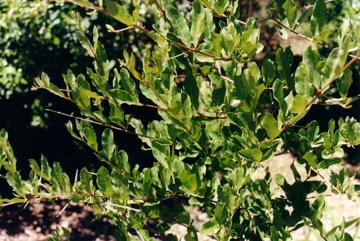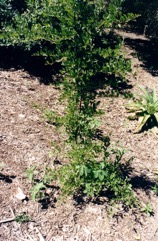Leadwood, Ivory tree

A tropical plant. It is usually on good soils. It grows in woodland and along streams. It grows at medium to low altitudes. It is often in mixed woodlands and along rivers. It especially grows in alluvial soils. It grows between 185-1,650 m above sea level. It can grow in salty soils. It can grow in arid places. Brisbane Botanical Gardens.
Also known as:
Hardekool, Impondozendhlovu, Lipholovu lendlovu, Loodhout, Mgodo, Mkolongonjo, Mnangali, Mocoza, Monzo, Motswere, Motswiri, Msimbiti, Muando, Muchenarota, Mukotama, Munangar, Munyondo, Mutsviri, Omukuku, Omumborongbon, Umtshenalotha, Umtshwili
Synonyms
- Combretum imberbe Wawra var. dielsii Engl.
- Combretum imberbe Wawra var. petersii (Klotzsch) Engl.
- Combretum imberbe Wawra var. truncatum (Laws) Burtt Davy
- Combretum truncatum Laws
- Combretum petersii (Klotzsch) Engl.
- Combretum primigenum Engl.
Edible Portion
- Gum, Leaves, Fruit - gum
Where does Leadwood grow?
Found in: Africa, Angola, Australia, Botswana, Central Africa, East Africa, Eswatini, Malawi, Mozambique, Namibia, South Africa, Southern Africa, Swaziland, Tanzania, Zambia, Zimbabwe
Notes: There are about 255 Combretum species.
Growing Leadwood, Ivory tree
Cultivation: Plants can be grown from seed. The whole fruit is soaked in water and then planted. Seedlings germinate in 7-15 days. Seedlings can be transplanted at the 3 leaf stage.
Edible Uses: Occasionally an edible gum is produced. It is produced from damaged parts. It is used for confectionary. The leaves are eaten as a green vegetable.
Production: It is a slow growing tree. It grows about 8 cm in one year. Trees can live for 1,000 years.
Nutrition Info
per 100g edible portion| Edible Part | Energy (kcal) | Protein (g) | Iron (mg) | Vitamin A (ug) | Vitamin c (mg) | Zinc (mg) | % Water |
|---|---|---|---|---|---|---|---|
| Gum | 328 | 1.3 | 3.9 | - | - | 0.5 | 11.4 |
Leadwood, Ivory tree Photos


References
Fowler, D. G., 2007, Zambian Plants: Their Vernacular Names and Uses. Kew. p 19
Fox, F. W. & Young, M. E. N., 1982, Food from the Veld. Delta Books. p 157
Grivetti, 1976, 1979,
Grivetti, L. E., 1980, Agricultural development: present and potential role of edible wild plants. Part 2: Sub-Saharan Africa, Report to the Department of State Agency for International Development. p 79
Lee, 1979,
Long, C., 2005, Swaziland's Flora - siSwati names and Uses http://www.sntc.org.sz/flora/
Mannheimer, C. A. & Curtis. B.A. (eds), 2009, Le Roux and Muller's Field Guide to the Trees and Shrubs of Namibia. Windhoek: Macmillan Education Namibia. p 360
Palgrave, K.C., 1996, Trees of Southern Africa. Struik Publishers. p 669
Palmer, E and Pitman, N., 1972, Trees of Southern Africa. Vol. 3. A.A. Balkema, Cape Town p 1651
Peters, C. R., O'Brien, E. M., and Drummond, R.B., 1992, Edible Wild plants of Sub-saharan Africa. Kew. p 86
Plowes, N. J. & Taylor, F. W., 1997, The Processing of Indigenous Fruits and other Wildfoods of Southern Africa. in Smartt, L. & Haq. (Eds) Domestication, Production and Utilization of New Crops. ICUC p 188
Rodin, 1985,
Royal Botanic Gardens, Kew (1999). Survey of Economic Plants for Arid and Semi-Arid Lands (SEPASAL) database. Published on the Internet; http://www.rbgkew.org.uk/ceb/sepasal/internet [Accessed 10th April 2011]
Ruiters-Welcome, A. K., 2019, Food plants of southern Africa. Ph.D. thesis. Univ. of Johannesburg p 45
Sitzungsber. Kaiserl. Acad. Wiss. Wien, Math.-Naturwiss. Cl. 38:556. 1860
Swaziland's Flora Database http://www.sntc.org.sz/flora
van Wyk, B, van Wyk, P, and van Wyk B., 2000, Photographic guide to Trees of Southern Africa. Briza. p 91
Venter, F & J., 2009, Making the most of Indigenous Trees. Briza. p 108
Wehmeyer, A. S, 1986, Edible Wild Plants of Southern Africa. Data on the Nutrient Contents of over 300 species
Williamson, J., 2005, Useful Plants of Malawi. 3rd. Edition. Mdadzi Book Trust. p 75
World Checklist of Useful Plant Species 2020. Royal Botanic Gardens, Kew
www.zimbabweflora.co.zw 2011